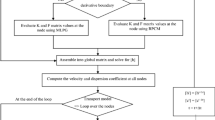Abstract
In this work, lowest-order Raviart–Thomas and Brezzi–Douglas–Marini mixed methods are considered for groundwater flow simulations. Typically, mixed methods lead to a saddle-point problem, which is expensive to solve. Two approaches are numerically compared here to allow an explicit velocity elimination: (1) the well-known hybrid formulation leading to a symmetric positive definite system where the only unknowns are the Lagrange multipliers and (2) a more recent approach, inspired from the multipoint flux approximation method, reducing low-order mixed methods to cell-centered finite difference schemes. Selected groundwater flow scenarios are used for the comparison between hybrid and multipoint approaches. The simulations are performed in the bidimensional case with a general triangular discretization because of its practical interest for hydrogeologists.
Similar content being viewed by others
References
Aavatsmark, I.: An introduction to multi-point flux approximation for quadrilateral grids. J. Comput. Geosci. 6(3–4), 405–432 (2002)
Aavatsmark, I., Barkve, T., Bøe, Ø., Mannseth, T.: Discretization on non-orthogonal, quadrilateral grids for inhomogeneous, anisotropic media. J. Comput. Phys. 127, 2–14 (1996)
Aavatsmark, I., Eigestad, T., Klausen, R.A., Wheeler, M.F., Yotov, I.: Convergence of a symmetric MPFA method on quadrilateral grids. J. Comput. Geosci. 11(4), 333–345 (2007)
Brezzi, F., Fortin, M.: Mixed and Hybrid Finite Element Methods, vol. 15. Springer, New York (1991)
Brezzi, F., Fortin, M., Marini, L.D.: Error analysis of piecewise constant approximations of Darcy’s law. Comput. Methods Appl. Mech. Eng. 195(13–16), 1547–1599 (2006)
Chavent, G., Roberts, J.E.: A unified physical presentation of mixed, mixed-hybrid finite elements and usual finite differences for the determination of velocities in waterflow problems. Adv. Water Resour. 14(6), 323–352 (1991)
Davis, T.A., Duff, I.S.: A combined unifrontal/multifrontal method for unsymmetric sparse matrices. ACM Trans. Math. Softw. 25(1), 1–20 (1999)
Eigestad, G.T., Klausen, R.A.: Convergence of the MPFA O-method: numerical experiments for discontinuous media. J. Numer. Methods Partial Differ. Equ. 21, 1079–1098 (2005)
Eisenstat, S.C.: Efficient implementation of a class of preconditioned conjugate gradient methods. SIAM J. Sci. Statist. Comput. 2, 1–4 (1981)
Fontaine, V., Younès, A.: On the multipoint mixed finite volume methods on quadrilateral grids. In: Proceedings of the XVI international conference on computational methods in water resources, p. 10 (2006)
Fraeijs de Veubeke, B.X.: Displacement and Equilibrium Models in the Finite Element Method. Stress Analysis, New York (1965)
Klausen, R.A., Russell, T.F.: Relationships among some locally conservative discretization methods which handle discontinuous coefficients. J. Comput. Geosci. 8, 341–377 (2004)
Klausen, R.A., Winther, R.: Robust convergence of multi point flux approximation on rough grids. Numer. Math. 104, 317–337 (2006)
Leij, F.J., Dane, J.H.: Analytical solution of the one-dimensional advection equation and two or three-dimensional dispersion equation. Water Resour. Res. 26, 1475–1482 (1990)
Raviart, P.A., Thomas, J.-M.: A mixed finite element method for second order elliptic problems. In: Mahematical Aspects of Finite Element Method. Lecture Notes in Mathematics, no. 606, pp. 292–315. Springer, New York (1977)
Roberts, J.E., Thomas, J.-M.: Mixed and hybrid finite element methods. In: Handbook of Numerical Analysis. Finite Element Methods, vol. II, Part. 1, pp. 523–639. North-Holland, Amsterdam (1991)
Vohralík, M.: Equivalence between lowest-order mixed finite element and multi-point finite volume methods on simplicial meshes. M2AN Math. Model. Numer. Anal. 40(2), 367–391 (2006)
Wheeler, M.F., Yotov, I.: A multipoint flux mixed finite element method. SIAM J. Numer. Anal. 44(5), 2082–2106 (2006)
Younès, A., Ackerer, P., Chavent, G.: From mixed finite elements to finite volumes for elliptic PDEs in 2 and 3 dimensions. Int. J. Numer. Methods Eng. 59(3), 365–388 (2004)
Younès, A., Fontaine, V.: Efficiency of mixed hybrid finite element and multipoint flux approximations methods on quadrangular grids and highly anisotropic media. Int. J. Numer. Methods Eng. 76(3), 314–336 (2008)
Younès, A., Fontaine, V.: Hybrid and multi point formulations of the lowest order mixed methods for darcy’s flow on triangles. Int. J. Numer. Methods Fluids 58(9), 1041–1062 (2008)
Author information
Authors and Affiliations
Corresponding author
Rights and permissions
About this article
Cite this article
Fontaine, V., Younes, A. Computational issues of hybrid and multipoint mixed methods for groundwater flow in anisotropic media. Comput Geosci 14, 171–181 (2010). https://doi.org/10.1007/s10596-009-9141-2
Received:
Accepted:
Published:
Issue Date:
DOI: https://doi.org/10.1007/s10596-009-9141-2




